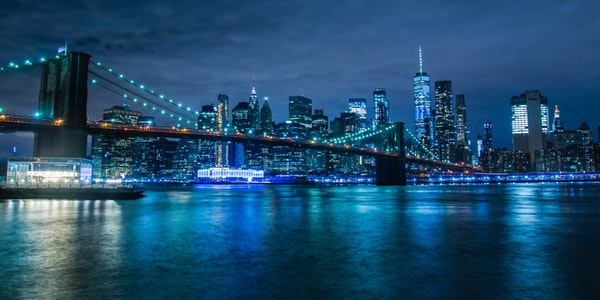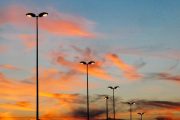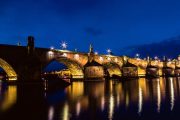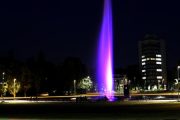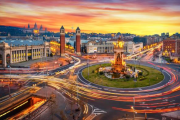The Meaning of bridge Landscape Lighting
A bridge is an extension of a road and a large-scale structure. The bridge is not only a part of the road, but also a special node connecting the road. Urban road lighting basically uses rows of street lamps standing on the side of the road as functional lighting. It is characterized by high efficiency, uniform light distribution, and good inducibility at the same time.
But for the functional lighting of the bridge, if rows of street lights are arranged in the original rhythm without change, the feeling of road extension is reflected, but the feeling of bridge nodes is weakened. Especially bridges in key urban areas have rich and special shapes, and their functional lighting design should strive to not affect the integrity of their overall shape during the day. At night, it can strengthen the special traffic, geographical location, and special structure characteristics of the bridge, so that people will have changes and jumps in both visual and psychological feelings.
In addition, the night lighting design of urban bridges must not only highlight the beauty and artistry of the bridge, but also integrate with the surrounding environment art where the bridge is located. This is the current development trend and specific expression of bridge night lighting design. The following is a discussion on the specific design ideas of night lighting for urban bridges.
Design Principles
Do a Good job in the Environmental Analysis of the Bridge Night Scene Project
Before launching the night scene lighting design of urban bridges, it is necessary to carefully analyze the location, function, and surrounding environment of the bridge to be designed in order to provide sufficient support for the design.
1. Analyze the Geographical Environment of the Bridge and Simulate the Oservation Point of View
Analyze the geographical environment of the bridge in detail and simulate the observation point of view, carefully observe the location of the bridge to be designed in the city, the distribution of nearby traffic arteries and roads, and confirm whether the designed bridge is located in the city’s central business district, scenic area or other functions Area.
It is necessary to observe the bridge body form and the size of the sense of volume of the bridge to be designed, and the viewpoints of the vehicles and pedestrians of the bridge. No matter which direction the bridge leads to the city, it is necessary to fully reflect the direction and viewpoint of the bridge and the beauty of the bridge body in the design of the night scene lighting of the bridge as much as possible.
The designer also needs to observe the condition of the bridge from the perspective of pedestrians. It is necessary to comprehensively and systematically observe the entire bridge, including whether the structure of the bridge body is rich, and whether the design space for designers is sufficient, as a viewpoint on the tall buildings or crowded areas around the bridge area.
At the same time, it is necessary to understand whether the anti-collision railing of the bridge can meet the lighting design of pedestrians and vehicles. We must not only reflect the fluency of the bridge, but also show a certain artistic rhythm. The designer can also consider the installation of built-in guardrail street lights above the anti-collision railing. This design method can well circumvent the weakness of traditional high-pole street lights obstructing the view, and create a transparent and concise landscape effect during the day. If equipped with bridge abdomen and bridge pier wall washers, it will produce a richer three-dimensional night scene effect.
2. Analyze the Light Environment Around the Bridge
Carefully analyze the light environment around the bridge to be designed. The functional lighting of the bridge is realized by the street lights on the bridge. If the bridge to be designed is multi-layered, designers generally pay more attention to the design of the upper and middle floors of the bridge. Because the relative light environment of this part of the bridge makes its brightness relatively high, while the approach part of the bridge is relatively dark.
Generally, the volume of the bridge body of the bridge is very large, because the shadow part of the bridge is usually the darkest area of the entire bridge. Generally speaking, the bridge area where large bridges are located is relatively bright, so in the night scene lighting design of the entire bridge, it is necessary to consider hiding the landscape lighting lamps as much as possible to play the role of decorating and beautifying the bridge.
3. Analyze the Cultural Environment Around the Bridge
Analyze in which functional area of the city the bridge to be designed is located, the number of surrounding buildings and scenery, and whether the location is superior or not. It is necessary to grasp the flow of people in the area where the bridge is located during the day and the conditions of the flow of people at night.
Thematic positioning of night scene lighting design
Combining the main design of the bridge, the characteristics of the bridge type and the overall effect, the theme of the bridge night scene lighting design must echo the main design, so that the night effect can reflect the other side of the bridge’s beauty.
Design Elements
- Attach to the bridge structure to shape the image of the night scene of the bridge
The beauty of the night view of the city is expressed through the iconic structure of the city buildings and buildings with lighting installations. The night view of the bridge is a perfect combination of bridge architectural art and lighting technology, showing people the beauty of bridge architecture.
In the city, the huge volume of the bridge and the unique ribbon structure determine the design of the bridge night scene has its own characteristics. The lighting design of the bridge night scene should first be based on the shape and material of the bridge to design the lighting effect and create the atmosphere expected at night.
On the basis of detailed analysis of the characteristics and image connotation of the bridge, through the changes of light and shadow, the bridge reshapes a new night scene image that is obviously different from the daytime.
Bridges are a typical example of structural logic. Expressing the structure and expressing the continuity of the road is the correct way for the bridge lighting design, and the decoration practices that deviate from the structure can not produce further affinity with the bridge.
When illuminating the pontic, the main methods should be to express the smoothness of the main structure and the mechanical relationship of the structure, and use linear light sources for continuous pontic rendering.
Create bridge landscapes around the possibility of function and structure, and at the same time regard bridges and roads as a unified whole, forming a higher level of visualization of the city.
The bridge body is melted into the traffic circle to form an overall continuous urban traffic function, realize the landscaping of the traffic system on a large scale, and enhance the recognizability.
2. Illumination color
Accurate color positioning highlights the three-dimensional sense of the bridge. Just as the color is used in the surface treatment of bridges, the positioning of the lighting color of the bridge night scene lighting design is equally important. Accurate color selection of lighting elements, control the illumination angle of the light, and arrange the light sources in a non-uniform and diffuse manner, so that the illumination of the main and secondary illumination surfaces and the projection surface can be reasonably distributed to obtain the maximum three-dimensional effect.
For example, the NY Brooklyn Bridge with yellow as the main color, and blends with the overall building color around it, at night, the bridge can give people a refreshing three-dimensional effect and make people feel very comfortable.
3. Highlight the key points of the bridge
The purpose of bridge night lighting design is to highlight the key points of the bridge itself and highlight the soul of the bridge night view. After in-depth understanding of the surrounding environment of the bridge, the lighting method is used to fully highlight the position of the illuminated subject of the bridge in the surrounding environment, and to maintain coordination with the surrounding environment lighting. The main body of the bridge should select key lighting, highlight key parts, and refine local lighting. The brightness change of the bridge must be naturally transitioned and layered to ensure the night scene lighting effect.
case analysis
In order to ensure the unity of the designer’s overall concept, many famous bridges do not set up light poles, but use other lighting methods.
For example: Hungerford Bridge uses the tower to install lighting fixtures. Bach deRoda Bridge adopts the combination of isolation belt and functional lighting, which perfectly combines bridge art and lighting form to bring people a unique passing experience.
The following is the design of a circular bicycle traffic flyover in Eindhoven, the Netherlands-a practical case project combining the integrated design of functional landscape lighting, hoping to inspire and help the lighting design of current bridges or special-shaped bridges.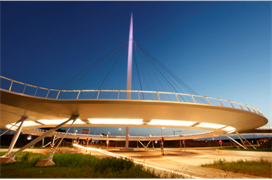
Design reason
This 72-meter-diameter circular bicycle traffic flyover is located in Eindhoven, the Netherlands. Its modern design, impressive tower height, thin volume and dazzling lights, like flying butterflies, have become an exciting new traffic landmark in the city.
Located at the gateway of the city, the cable-stayed bridge design provides an exciting intersection for cyclists and pedestrians. There used to be a level crossing here, but the development of nearby real estate projects caused the original roads to fail to meet the traffic demand, and the underground bicycle traffic roads and circuitous bicycle routes were both undesirable schemes for the government. Finally, the Dutch bridge expert ipv Delft used a beautiful circular cable-stayed bridge solution that met all the requirements.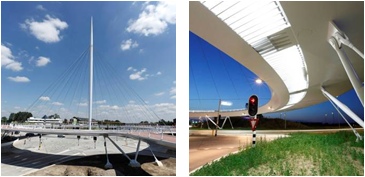
Design ideas
Despite the limited space, ipv had a very clear vision at the beginning of the design: the bridge visually consists of a thin circular deck and a powerful tower bridge. The bridge we see today is composed of a 70-meter-high tower, 24 steel cables, and a circular bridge deck. The shape of the steel cables (which together form a V-shape) and the corresponding cigar-shaped cable tower make the cables evenly distributed and pull on the inner side of the bridge deck to prevent uneven forces on the bridge deck. The layout of the deepened nodes will eventually form a comfortable bicycle ramp on the bridge. The M-shaped support structure on the ground is the result of extensive exploration of possibilities and also ensures the stability of the bridge deck.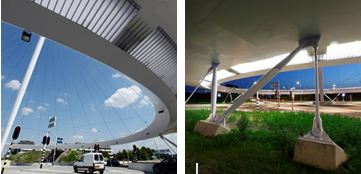
Pontic structure
Including the bridge tower is 70 meters high, 24 steel cables and a circular bridge deck, the consumables are about 10 million tons of steel. The cable connects the inner bridge deck, the circular letter of the bridge deck connection, and the concrete counterweight. In this way, the torsion of the bridge deck with an inner diameter of 72 meters can be avoided.
Soon after it was put in place, the hangers and cables began to vibrate noticeably, and it was almost impossible to predict vibrations like these caused by wind. After extensive research by structural experts, two types of dampers (high frequency and low frequency) are connected to the cable to solve the vibration problem.
Integration and lighting
- Spatial integration
One of the challenges faced in the design process is spatial integration. The existing infrastructure and buildings will affect the slope of the ramp linking the bridge. For this reason, the pavement under the shell is lowered by 1.5 meters to ensure that the ramp connecting the bridge and the bicycle lane has a comfortable inclination. In addition, the beautifully shaped and thin bridge has overcome many structural and technical challenges.
- Lighting integration
Philips Lighting designed the night lighting effect for the bridge and turned it into a spectacular “city light”.
One of the light bands is distributed on the lower and inner side of the road surface, forming a strong ring-shaped lighting effect. One of its main lighting elements is integrated into the circular bridge deck.
The space between the counterweight and the bridge deck has been installed with multi-layer aluminum sheet panels, translucent wall panels and tube lighting, which will eventually form a clearly visible ring light at night. Together with the lighting tower, the ring of light ensures the spectacular appearance of the bridge at night.
Functional lighting is integrated into the railings, where LED lighting illuminates the bridge deck and ensures that the bridge is facial recognition of users at the same time, ensuring the safety of riding at night.
The inner surface of the circular counterweight between the tower and the bridge deck is connected below the intersection illuminated by the lights of a cable frame. The tower bridge is a circular counterweight that connects the frame between the cable tower and the bridge deck and the inner surface to illuminate the intersection lights below. No matter day or night, this tower bridge is a fascinating place.


